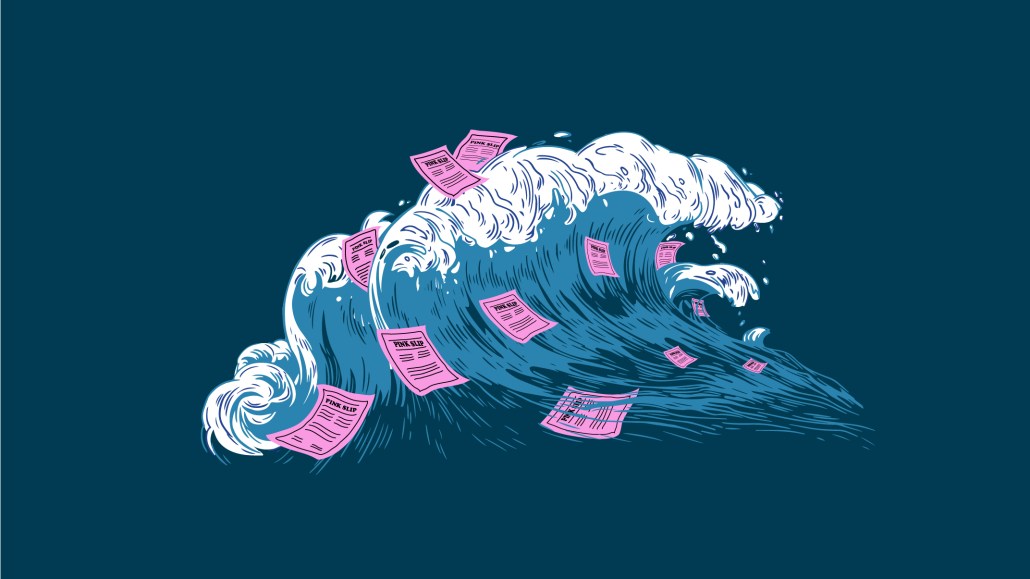Register by Jan 13 to save on passes and connect with marketers from Uber, Bose and more

In the spring, a wave of pay cuts, furloughs and layoffs crashed over media as the coronavirus swept through the American economy. Now, a second wave appears to be rising, after the speedy recovery publishers hoped for failed to materialize.
On Thursday, Vox Media sent a memo to employees announcing it was laying off 6% of its staff, many of them staffers that had been furloughed earlier in the year. On Wednesday, Guardian News & Media announced that it would eliminate 180 jobs, 70 of them editorial, citing a $31 million shortfall in revenue, and the BBC announced it was trimming another 70 jobs of its own, months after announcing it was laying off 450 people at regional newsrooms.
Earlier in the week, McClatchy, which just emerged from a bankruptcy auction won by the private equity firm Chatham Asset Management, announced that 84 of the 115 employees it furloughed in April would be laid off.
Beyond job cuts, employees will face more belt-tightening too. On Wednesday afternoon, Gannett told staffers employee benefits would be slashed.
And with the American economy still languishing, those layoff headlines likely won’t be the last of the year.
“It probably will get worse,” said Jon Schleuss, the president of the News Guild. So far, Schleuss said his organization, which helped organize unions at publications including the Los Angeles Times and BuzzFeed News, has lost “around 200” members due to cuts spurred by the pandemic.
2020 has been an especially grim year for reporters and editors. 50% of publisher respondents to a Digiday survey said there had been either furloughs or layoffs at their companies. Newsrooms have lost over 11,000 jobs through the first half of 2020, on pace to smash the record 14,000 newsroom job losses posted in 2008, according to research conducted by outplacement firm Challenger, Gray and Christmas.
Some of those cuts made earlier this year reflected practical realities – maintaining a large events team makes little sense when the entire country is in lockdown, for example. But sources at publications that had pandemic-driven layoffs say that the cuts limit their ability to turn their businesses around.
“Some of the cuts were completely understandable,” said a source inside The Economist, which laid off some 90 people in May. “Some felt completely nonsensical and showed a lack of understanding of how the business works and what clients need.”
Cuts made on the commercial side, that source said, set up a grim domino effect: Fewer resources to put into pitches lowers the chance of winning business, which lengthens the time between when clients work with publishers, which brings the future of the relationship into question.
“If partners lived without you for a while and were okay, do they really need you?” that source asked.
Reached for comment, a spokesperson for the Economist responded, “Of course it can be really difficult to see our colleagues and friends leave the business under these circumstances. These were tough decisions and they were taken only after all other options were explored. And these changes are to ensure the long term viability of our business and protect the key areas of our business that underpin future growth: our journalism, product and technology capabilities, solution sales and improvements to marketing capabilities, digital platforms.”
As ugly as the second quarter of 2020 was for many publishers — 80% of respondents to a Digiday survey said they had to lower their second quarter revenue targets — some publishers allowed themselves to be optimistic that things would improve once the U.S. got the virus under control.
And after many advertisers got over the shock of March and April, spending in many categories did come back, albeit in an all-or-nothing kind of way.
Yet as the virus’s infection rate continues to rise across the country, particularly in large states including Texas, California, Florida and Arizona, the optimism that had crept into some executives’ thinking has evaporated.
“We had a survey fielded in early May where people were a lot more optimistic, and that has reversed,” said Nicole Perrin, eMarketer’s principal analyst. “I know I was having conversations about things largely being normal by September. Now I don’t know if anyone feels that way.”
Last month, eMarketer revised its 2020 projections for the digital advertising market, down from a 17% increase year over year to a 1% increase, Perrin said.
In place of that optimism is a renewed sense of uncertainty. In some cases, that has led to pleasant surprises. A top revenue executive at one large digital publisher who asked not to be identified said their organization missed its second quarter revenue projections by 40% and entered the third quarter expecting to miss their revenue targets by 30%.
Just a few weeks in, that CRO said, there is a slim chance they might only miss their original targets by a few percentage points. But the fourth quarter remains a question mark. “People aren’t really even planning,” that source said.
Some media leaders are bracing for the possibility that the economy will slide even further, once stimulus programs like the Paycheck Protection Program, the CARES Act and unemployment benefits begin to wear out. “I think some of the worst is still coming,” BuzzFeed CEO Jonah Peretti told The Information this week.
More in Media

Why publishers are building their own creator networks
Publishers are forming creator networks to regain control, combat traffic declines, and reach audiences shifting toward influencers.

The accidental guardian: How Cloudflare’s Matthew Prince became publishing’s unexpected defender
Cloudflare’s day job is fending off botnets and nation-state cyberattacks, not debating how Google and other AI firms crawl publisher sites.

A timeline of the major deals between publishers and AI tech companies in 2025
Here’s a list of all the major deals signed between publishers and AI tech companies in 2025.





